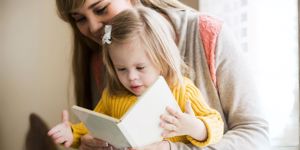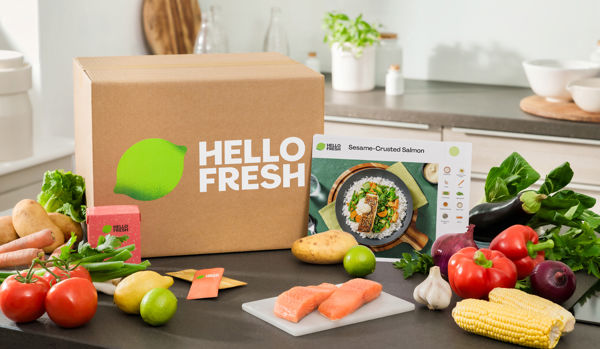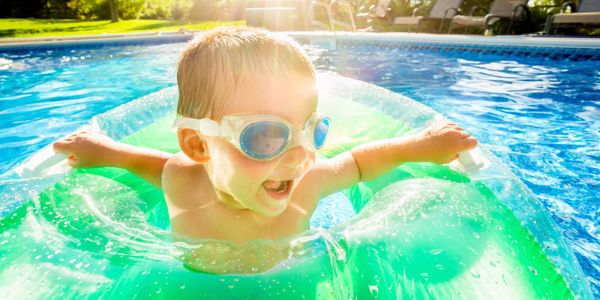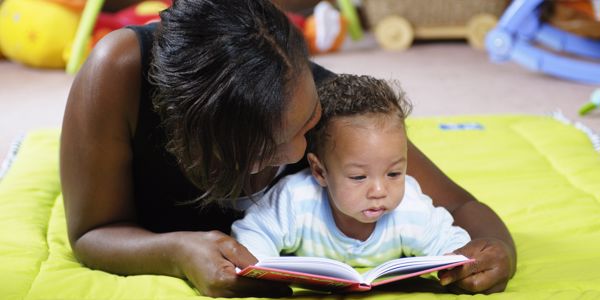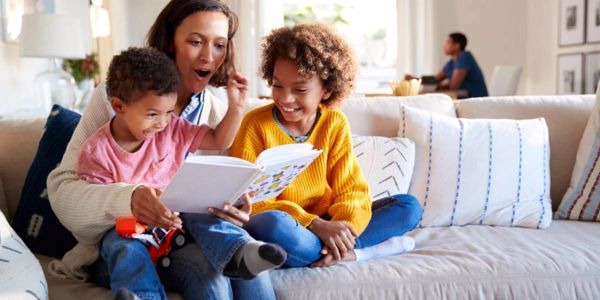If you have a toddler you may find that they are a sponge for learning and into everything.
Books play an integral role in the development of your child, and there is no better time to start reading to them daily than at this age. You should also allow them to look at picture books with singular words in them.
The more variety you can introduce at this stage the more likely your toddler is to recognise the words and images. By reading to your toddler, you are introducing them to words, speech and tone of voice, as well as the storytelling aspect of a book, which in turn sparks imagination and language. If you can read just one book to your child every day you will be allowing their brain to develop more social skills and stimulate their ability to learn.
You should also create a time of day that is specific to this, it’s good for routine and something your toddler will look forward to. Cuddling up on a chair together with a book will also help their social development and how they express themselves as they get older. The comfort and development that comes from reading for and with your child cannot be overlooked.
Books demand that we think, we use our imagination and we also recognise words and understand them. When a toddler is expanding their skills it’s important that the books that are being supplied give those children new ways to think and learn because books aid vocabulary and imagination like no other form of media. Listening to you and watching you speak is also imperative to this learning curve they have as toddlers.
So, where do you begin to look at books that will assist your toddler's development in the best way possible? There are so many on the market, so let’s break toddler books down into three different categories. These are Interactive Books, Story Books - Literature, Fiction and Imagination Books (Storytelling) and Educational, Learning and Reference Books.
Interactive Books
There are a range of interactive books on the market these days, they usually have a moveable aspect like pop-up parts or different textures integrated within the pages.
Lots of these have one thing in common: the child is meant to be physically touching the book and using their fine motor skills to touch it with their fingers and hands. Your child will really benefit from this interaction if they are currently into touching everything in order to learn about it. Textures allow the toddler to experience something physical while learning and reading.
One book that has always been a favourite in our house was ‘Dear Zoo’. Our ‘Dear Zoo’ book has the animals inside various boxes, crates and cages and the toddler has to see what’s underneath those in order to find the animal. What fun! If you can also incorporate animal noises while reading books like this then the sound can also stimulate other development.
[Buy ‘Dear Zoo’ here: https://amzn.to/3GIC7b6]
Another wonderful book series is ‘That’s not my ___’ where children can come across objects, animals, vehicles and the like, and there will be textural elements of a very simple style book. Large, bright pictures coincide with a material and a very easy-to-understand set of sentences. Your toddler will be stimulated by the pictures, words and texture while enjoying these types of books.
[Buy ‘That’s Not My’ here: https://amzn.to/3uZaWWQ]
There are also books with built-in sounds to consider, books that mimic animal sounds or I have even seen books where the story follows and sounds are made at certain words in the story, such as a “Choo Choo” for a train passing.
These types of books allow noise to become a part of development, and a child will recognise it upon repetition. Don’t be surprised if you buy a book with sounds and it becomes the one they want to read again and again. If you can’t get one and you’re reading a book which has animals in, then why not do the sounds yourself!
Story Books - Literature, Fiction and Imagination Books
Stories are something most of us enjoy at any age of our lives, but when it comes to toddlers they want to be drawn in quickly and their attention held. Be it by incredible pictures or fun words that are repeated like “Splat Splat Splat” or “Quack Quack Quack” but whatever it is, it needs to be fun. Toddlers don’t need long stories; in fact, lots of short stories are better for this age group.
Sparking your child’s imagination is the most important thing alongside their learning, and your child will enjoy the time you spend together the more you read to them. Soon, they will be reading alongside you, so make the most of this wonderful age.
Stories are an integral part of learning to read and about using your imagination. Try reading simple stories with your toddler to start with, especially ones that have large pictures so that they can follow along easily, too.
Learning and Development Books
“My first words” books can be seen as boring to us parents, but to a toddler, they are about the repetition and the bright pictures.
I always suggest books that have real photography in them where possible so that accurate learning is achieved. Correct colours and orientation are important for toddlers to begin noticing the world around them. A Cow is black and white, for example, and not purple like it may be shown in a made-up story.
Always sit down with your toddler and ask them to point out things they might recognise, if you have a cat, you may ask if they know which picture is of a cat. Start with things they are likely to have already come into contact with, such as a house or a car, and move on to harder pages as they learn. Looking at books with real photography in them means your child is more likely to get it right when asked about something in reality.
There are tons of educational and learning books on the market and you can also get ones dedicated to individual genres such as shapes, colours, space, animals, etc. Start with books that your child has shown an interest in. My son has always loved numbers and animals, for example.
Some of the UK’s favourite development books are made by the likes of DK and Usborne. There is also Sweet Cherry Publishing, which makes books featuring Numberblocks and Alphablocks from BBC CBeebies shows which are board books and perfect for toddlers and preschool ages.
Best Interactive Books for Toddlers
Axel Scheffler – On the Farm (Push, Pull, Slide Book)
Buy it here: https://amzn.to/3tef7h3
DK Pop Up! Peekaboo! Colours / Baby Animals / Under the Sea – pop up surprise books
Buy it here: https://amzn.to/48hLDha
Usborne Touchy Feely Books – “That’s Not My-“ range of books
Buy it here: https://amzn.to/3uZaWWQ
Eric Hill – Where’s Spot (Lift the Flap Book)
Buy it here: https://amzn.to/46ZJs0G
Best Story Books for Toddlers
Eric Carle – The Very Hungry Caterpillar
Buy it here: https://amzn.to/48i43hS
Judith Kerr – The Tiger Who Came to Tea
Buy it here: https://amzn.to/41mstUW
Jill Murphy – Five Minutes Peace and Other Stories
Buy it here: https://amzn.to/3NqCt9T
A.A Milne Winnie The Pooh Collection of Stories
Buy it here: https://amzn.to/3RICUzc
Best Educational, Learning and Reference Books for Toddlers
DK My First Words Let’s Get Talking
Buy it here: https://amzn.to/3tgKyam
First 100 words
Buy it here: https://amzn.to/3RHlYJc
Eric Carle – A Big Book of Little Books
Buy it here: https://amzn.to/3GFICvc
How I Got Books Into Our Routine
My son is now aged five and he still loves books. I first started reading to him and showing him high contrast picture books from only a few weeks old. I did books twice a day with him while I was on maternity leave and made sure it was a similar time every single day. Implementing books into our daily routine was a way of keeping learning fun and as he got older my son became used to it being an everyday occurrence.
Books are an integral part of learning and it’s important your child looks forward to this time of day and has a willingness to learn. As a toddler, I would ask him to choose a book off his designated shelf, and I also taught him to put them back too.
The books that he loved the most contained animals or brightly coloured pages, and when I got him a “First Words” book by DK, it quickly became one he would look at every single day. You can even keep the baby books you buy when they are under age one and use them as first word books too; they usually just have one picture per page and a word such as Cat or Cow or Dog, so these are perfect for that age range as well.
As a toddler, we would read one story and then have an educational book to look at afterwards, this could be a single topic or a first shapes, first colours, first words type of book. My son would usually like me to read them and he would try and copy my words. Repetition is essential at this age for language and speech development. I would also suggest that you get your toddler to watch your mouth when you are speaking; this helps them recognise words quicker.
Our favourite books for the Toddler stage are:
Eric Carle – a Big Box of Little Books: (includes Sky, Sea, Garden, Forest etc, titled books with animals in the style of Eric Carle’s artistry). This wonderful set has nine books made of board, great for little hands and beautifully brightly coloured pictures of animals from Earth.
DK – My First Words “Let’s Get Talking”: a book with tabs along the top and sided for various categories such as ‘Food and Drink’, ‘Pets’, ‘Things That Go’, ‘In The Wild’, ‘Colours’ and ‘Shapes’ , etc. This has been well used and my son will still look at it now he is older too. All the images inside are of real-life objects and animals, etc. Photography is used throughout, which makes it realistic so that a toddler can differentiate between it in the real world around them.
David Melling – 1, 2, 3, SPLOSH!: A wonderfully fun book about ducks trying to get into a paddling pool. My son asked for this again and again and would laugh at my funny interpretations of the ducks. It helped him to learn to count, too, because I would ask him to count the ducks as we turned the pages.
Paw Patrol – Little Learning Library: Four Books for Toddlers including ‘Colours’, ‘Numbers’, ‘Animals’ and ‘Opposites’. My son has always been a fan of the Paw Patrol Pups but I have seen these little libraries in over a dozen variations, so you should be able to find one relevant to what your toddler enjoys, such as Thomas the Tank Engine, Peppa Pig, Bluey, Dear Zoo, The Gruffalo, Hey Duggee, Cocomelon, Little Miss and Paddington among others. They are all very similar and often have very few words on the page but brightly coloured pictures. Perfect for grabbing a toddler’s attention with the characters they know and love helping them to learn.
Wilderness Press 100 First Words: Another wonderful book which is toddler sized and has lovely clear drawings in it. Categories make it easy for a little one to understand, such as Getting Dressed and On The Farm etc. Although illustrated, this book is very good and doesn’t have too many questionable colour changes like some books I have seen before. You want to have accuracy and fact when teaching little ones about the world around them. This book also has Numbers on the final double-page spread where little fingers can count each item, like four Penguins or nine Apples.
Eric Carle – The Very Hungry Caterpillar: A book my son has always loved and this has continued all through his childhood, too. From listening to me read to identifying the fruits and counting them with me to reading along with me at story time, this book is perfect for all aged children. When my son did the lifecycle of a butterfly in his curriculum at primary school this book was read every single day. This is another book that will be useful to your child from the toddler stages right into the school years.
Ian Whybrow and Ed Eaves – Say Hello or Say Goodnight Range of Books: These books are wonderful stories and beautifully illustrated too. If you can get your hands on any, they make brilliant stories for any time of the day, there are six that we know of.
Remember that reading books together as a family will strengthen your bond with your child, they learn more while they feel safe and secure. That space you create for them will allow them to engage with books at their own pace. Reading can reduce stress and it also instils a lifelong passion for stories.
Reading young and as often as you can with your toddler will help them to learn all about the world around them as well as the joy that having an imagination brings. Enjoy the cuddles and read for at least fifteen minutes a day to encourage development; usually read after a nap when they are refreshed or implement into their bedtime routine. Reading is a wonderful thing to do with your family, and even if you cannot afford to buy many books, check out your local library. If someone asks if they can buy my son a gift at his Birthday or Christmas I nearly always suggest a book.


